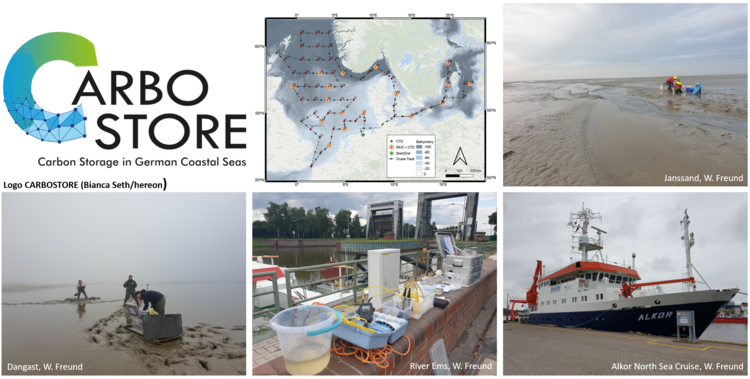CARBOSTORE
Carbon Storage in German Coastal Seas – Stability, Vulnerability and Perspectives for Manageability
Sulfurization of DOM as a mechanism for Carbon Storage by formation of recalcitrant dissolved organic matter (RDOM)

Dissolved organic matter (DOM) is the largest organic carbon pool in the marine environment exceeding the amount of carbon stored in the entire land biomass on earth. Refractory DOM (RDOM) in the ocean resists degradation for several hundred to thousands of years. Previous research suggested that abiotic sulfurization of DOM may increase the stability of (R)DOM. Additional sources of oceanic dissolved organic sulfur (DOS) are the production by organisms and anthropogenic input by rivers. Sulfur is abiotically incorporated into DOM under sulfidic conditions (Pohlabeln et al., 2017) in the water column and sediments (Gomez-Saez et al., 2021; Seidel et al., 2014; 2017).
In the CARBOSTORE project, we combine large-scale sampling campaigns in the Baltic and North Seas to reveal the main export pathways of sulfurized DOM. Furthermore, DOS fluxes will be determined in the German Bight combining sampling campaigns in the backbarrier tidal flats, rivers, and at the time series station at Spiekeroog Island. Laboratory incubation experiments will be used to assess the stability of DOS under various conditions. We will use quantitative chemical data and combine them with molecular proxies to track the sources and fate of sulfurized DOM in the ocean by using Fourier-transform ion cyclotron mass spectrometry (FT-ICR-MS). The experimental transformation and degradation rates will then be included in biogeochemical models.
With our research, we aim to answer (I) how the benthic sulfur cycle affects DOM sulfurization and the formation and stability of RDOM in the context of carbon storage and (II) how the export of RDOM into the North Atlantic and its exchange between the Baltic and North Seas will change in a warmer climate at elevated sea level. Our results will help evaluate the carbon sequestration potential of abiotic sulfurization in the Baltic and North Seas.
Webpage:
Funding:
MARE:N des BMBF zur Meeres- und Polarforschung im Förderbereich „Ozeane unter Stress“
List of people involved:
External Collaborators:
Helmholtz-Zentrum Hereon, Institut für Kohlenstoff-Kreisläufe
GERICS Climate Service Center Germany
Leibniz-Institut für Ostseeforschung Warnemünde - IOW
Nds. Landesbetrieb für Wasserwirtschaft, Küsten- und Naturschutz - NLWKN
Walther-Schücking-Institut für Internationales Recht (WSI), Christian-Albrechts-Universität zu Kiel
Institut für Meereskunde (ifM), Universität Hamburg
Publications
Gomez-Saez, G.V., Dittmar, T., Holtappels, M., Pohlabeln, A.M., Lichtschlag, A., Schnetger, B., Boetius, A., Niggemann, J. (2021) Sulfurization of dissolved organic matter in the anoxic water column of the Black Sea. Science Advances, 7: eabf6199.
Pohlabeln, A. M., Gomez-Saez, G. V., Noriega-Ortega, B. E. & Dittmar, T. Experimental evidence for abiotic sulfurization of marine dissolved organic matter. Front. Mar. Sci. 4, 1–11 (2017).
Seidel, M., Beck, M., Riedel, T., Waska, H., Suryaputra, IGNA, Schnetger, B., Niggemann, J., Simon, M., Dittmar, T. (2014) Biogeochemistry of dissolved organic matter in an anoxic intertidal creek bank. Geochim. Cosmochim. Acta, 140: 418-434.
Seidel, M., Manecki, M., Herlemann, DPR, Deutsch, B., Schulz-Bull, D., Jürgens, K., Dittmar, T. (2017) Composition and transformation of dissolved organic matter in the Baltic Sea. Front. Earth Sci., 5: doi: 10.3389/feart.2017.00031.



![[Translate to English:]](/f/5/_processed_/3/2/csm_ICBM-Logo-transparent-_91fe1c6774.png)